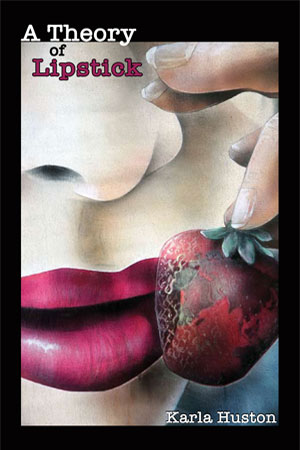Book Review
Karla Huston, A Theory of Lipstick, Main Street Rag Publishing Company, 2013
by Marina Oliver
Karla Huston’s A Theory of Lipstick explores delicate topics—femininity, aging, gender roles, desirability—with a sensitivity that makes for 90 pages of simmer. From the very first section, the book sheds light onto the ebb and flow of a human landscape. How much stock do humans place in their relation to others? How much of their identity stems purely from their own actions and what they hold within? Specifically, how do women perceive and navigate the world and how do they continue to do so?
“The Good Dog” exemplifies these questions. Written in couplets that suggest intimacy, at least on the surface, the poem uses lines such as “She’d humble herself looking so she’d get / her ears ruffled a little, although she never liked / anyone touching them, soft as they were” to set up the power dichotomy between the male handler and the femaleness of the dog. The poem’s central internal struggle climaxes with “The words sounded like that’s a good girl / and for a moment, she thought she was.” Huston portrays worth and desirability in a heartbreaking manner throughout the entirety of A Theory of Lipstick.
Huston crafts the namesake poem, “Theory of Lipstick,” recipient of a 2012 Pushcart Prize, with a powerful juxtaposition between sensual language and the appropriation of advertising culture:
Pot rouge, rouge pot, glosser, lip plumper, bee
stung devil’s candy and painted porcelain
Fire and Ice, a vermillion bullet,
dangerous beauty lipstick, carmine death rub, history
of henna. Fact: more men get lip cancerbecause they don’t wear lipstick or butter
jumble of a luminous palette with a brush made
to outlast, last long, kiss off, you ruby busser,
your gilded rose bud bluster is weapon and wine.
QE’s blend: cochineal mixed with egg, gum arabicand fig milk—alizarin crimson and lead—poison
to men who kiss women wearing lipstick, once illegal
and loathsome—then cherry jelly bean licked and smeared,
then balm gloss crayon, a cocktail of the mouth,
happy hour lip-o-hito, lip-arita, with pout-fashioned chasermade from fruit pigment and raspberry cream,
a lux of shimmer-shine, lipstick glimmer, duo
in satin-lined pouch, Clara Bow glow: city brilliant
and country chick—sparkling, sensual, silks
and sangria stains, those radiant tints and beeswax liberty—oh, kiss me now, oh, double agents of beauty
slip me essential pencils in various shades
of nude and pearl and suede, oh, bombshell lipstick,
sinner and saint, venom and lotsa sugar, lip sweet,
pucker up gelato: every pink signal is a warning.
It’s easy for the reader to get lost within the folds of lines like, “sparkling, sensual, silks / and sangria stains, those radiant tints and beeswax liberty—“ with the utter fluidity of the figures of speech. However, the backbone of the piece, constructed from language borrowed from consumer culture—usually used to soothe and entice a mass audience—instead adds a healthy dash of cynicism to the work. It sets up the slightly sinister feeling that culminates in “every pink signal is a warning,” in which the “essential” nature of beauty must be confronted head-on by the reader. The poem digs deeply into society’s conceptions of femininity, attraction, independence, and the power structure that dictates "normality" without ever losing its luscious linguistic guidance. The poem occurs relatively early in the book on page 17, but will stick with the reader throughout the volume, and will be conjured again for reference with the final poem, “Love That Red” with its return to the lipstick theme.
As A Theory of Lipstick draws to a close, the poetry embarks on a multi-faceted exploration of the concept of aging. In “O Hair,” childhood locks and “O hair of youth, / SunIn streaked” turn into “O ghostly hair and mystery, / I love the way you’ve grown” to bring a sense of acceptance and appreciation to the thought of change. A few pages earlier, Huston confronts aging and ageism in “Cheap Talk”:
While talking to students about aging
and sex the other day, I read disgust on their lips
when they considered parents and grandparents
having it. One kid said he couldn’t imagine
an old guy actually getting it up, not to mention
getting it in as if in were a destination on a wrinkled
map—hotel no-tell in a dusty town in Ohio. All that
cheap talk, their snortling and knowing smiles. Like sex
was only for the young and beautiful and doing it
were beautiful to see, which of course,
it isn’t. All those upended body parts, privates
exposed, the inside body smells, the playground
between two sewers, the plunge and grunt,
posturing for position. The worry about fit
and flattery, performance and review.
The act so mechanical: ball and socket,
tab and slot, push and shove, bang and
cushion. Of course no one thinks
about that—the acrobatics, the open mouths,
the hard wetness—the way it feels when man enters
the deep slice, the filling vessel—the hopeful work
to get it where it feels so damned right.
Coarse language paints a picture of adult interaction with few romantic frills. The honesty of the piece feels like a sobering splash of icy water to the face. It’s full of wisdom that can only come with aging.
Though A Theory of Lipstick tends to tackle social subjects particularly as they pertain to women, readers should be careful in classifying it as a book for women. It encompasses so much of the human experience that there is bound to be a relevant theme for every reader.
Marina Oliver is a student at UW-Madison and an intern for Verse Wisconsin.


